 September 11, 2014 John E. Ross, KD8IDJ, Editor
| ||||||
"Amateur Radio Parity Act of 2014" Co-Sponsor List Swells to 32 The number of co-sponsors for H.R. 4969, the Amateur Radio Parity Act of 2014, has reached 32 members of the US House of Representatives. The list includes 21 Republicans and 11 Democrats representing 17 states and the Commonwealth of Puerto Rico. The push to persuade additional House members to sign on as H.R. 4969 co-sponsors continues. ARRL Regulatory Information Manager Dan Henderson, N1ND, has pointed out that the House may adjourn as early as Friday, September 19, and not reconvene until after the mid-term elections on November 4. Members of the ARRL team have been in Washington, DC, to contact House members while Congress is still in session.
Letters directed for forwarding to US House of Representatives members via ARRL Headquarters will be printed beforehand. Henderson explained that this approach speeds delivery, since individual pieces of mail to members of Congress are scanned for threats. "We have received more than 3000 letters since the bill was introduced," Henderson said, adding that he was not sure how many more might arrive by week's end. "The more noise we make, the better our chances for the bill's passage," he said. Henderson emphasized that a successful outcome requires as many co-sponsors as possible, and letting House members hear from ARRL members in their role as voters and constituents can contribute to making that happen. The current campaign in support of H.R. 4969 only targets members of the US House, since the bill has not yet reached the Senate. While Congress was on break in August, the League encouraged members to meet with their representatives while they were home on break in their districts, and urge their support for H.R. 4969, Henderson said. In addition to a list of current co-sponsors, the League's H.R. 4969 page contains information and guidance for clubs and individuals promoting efforts to gain co-sponsors for the measure by contacting their members of Congress. The web page includes a sample letter to a member of Congress and a list of "talking points." Direct letters to H.R. 4969 Letter Campaign, ARRL, 225 Main St, Newington, CT 06111. If e-mailing your letter as an attachment, include the bill's number, H.R. 4969, in your subject line. Letters may also be faxed to 860-594-0259. The bill, which was introduced in the US House of Representatives with bipartisan support in late June, would call on the FCC to apply the "reasonable accommodation" three-part test of the PRB-1 federal pre-emption policy to private land-use restrictions regarding antennas. The bill's primary sponsor is Rep Adam Kinzinger (R-IL), and it received initial co-sponsorship from Rep Joe Courtney (D-CT). The limited PRB-1 pre-emption currently applies only to state and municipal land-use ordinances. The FCC has indicated its reluctance to provide the same legal protections from private land-use agreements -- often called covenants, conditions, and restrictions or CC&Rs -- without direction from Congress. H.R. 4969 has been referred to the House Energy and Commerce Committee. Rep Greg Walden, W7EQI (R-OR), chairs that panel's Communications and Technology Subcommittee, which will consider the measure. ARES/RACES Volunteers Mobilize in Wake of Nevada Flash Flooding ARES/RACES members in Clark County, Nevada, activated Monday, September 8, after heavy rains sparked flash flooding. The Amateur Radio volunteers deployed after being called up by local emergency managers to support communication during recovery efforts in the Moapa Valley northeast of Las Vegas. At least two people died as a result of the flooding.
Emergency sheltering was needed for nearly 200 tribal members of the Moapa River Reservation, as well as nearly 90 elementary and high school students. Stranded motorists were being cared for at a middle school in Mesquite, on the Arizona border. ARES personnel staffed the Emergency Operations Center in Las Vegas, and the Clark County Mobile Communications Vehicle was on the scene. -- Thanks to ARRL Nevada PIC John Bigley, N7UR FCC Enforcement Bureau Warns Two Hams for Failure to Identify Properly The FCC Enforcement Bureau has released Warning Notice letters it sent in July to two radio amateurs, advising them that it had monitored transmissions during which the licensees had failed to identify properly. The Bureau posted the correspondence earlier this month on its Amateur Radio Service Enforcement Actions web page. The two notices from FCC Enforcement Bureau Special Counsel Laura L. Smith, both dated July 21, contain essentially the same wording. In a Warning Notice to Gary E. Davis, W1IT, of Inman, South Carolina, Smith told Davis that he was monitored on July 15 and 16 at the FCC's High Frequency Direction Finding Center (HFDFC) in Maryland, failing to properly identify while operating on 7.185 MHz. "[Y]ou were heard by a Commission employee operating your Amateur Radio station for 20 minutes without identifying in a timely manner," Smith wrote. "The Commission employee used direction-finding equipment and confirmed the transmissions were coming from your location."
In a nearly identically worded Warning Notice to John J. Krajewski, KB3MZQ, of Newark, Delaware, Smith said the HFDFC also had monitored transmissions by him on July 15 and 16, also on 7.185 MHz, during which he failed to identify properly. Smith said the FCC had "recorded the offending transmissions" in both instances and offered to make copies available to Davis and Krajewski. She further advised Davis and Krajewski that recurring "operation of this type" after receipt of the warning letters, could subject them to "severe penalties, including license revocation, monetary forfeiture (fines), or a modification proceeding to restrict the frequencies upon which you may operate." In 2006, in response to a Petition for Rule Making, the FCC declined to modify its Amateur Service station identification rules. The petition received some 100 comments. In dismissing the petition the following year, the FCC concluded that the changes requested were "neither necessary nor supported by the Amateur Radio community," and that the failure-to-identify problem "would be better addressed by enforcement of the present rule, rather than a rule change." Canadian Regulator Accepts Radio Amateurs of Canada's International 60 Meter Allocation Proposal Radio Amateurs of Canada (RAC) has announced that its proposal to establish an international 60 meter Amateur Service allocation has been accepted by the Industry Canada consultative committee for World Radiocommunication Conference 2015 (WRC-15). The regulator uses that panel's conclusions to determine its position on WRC-15 issues. The RAC proposal specifically addresses WRC-15 Agenda Item 1.4 -- to establish a 60 meter allocation for Amateur Radio on a secondary basis. The Canadian proposal will be considered by other International Telecommunication Region (ITU) Region 2 countries in October.
The RAC proposal recommends two 25-kHz band segments for Amateur Radio -- 5330 to 5355 kHz and 5405 to 5430 kHz. Amateur access would be on a secondary, non-interference, listen-before-transmit basis. Gorsline credited the efforts of Bryan Rawlings, VE3QN, the RAC representative on domestic committees and a Canadian and International Amateur Radio Union (IARU) delegate at ITU meetings. "His role and the hours of work -- essentially an unpaid job -- attending many, many formal and informal meetings with our regulator and with interested parties in Canada and internationally are a key factor in gaining formal Canadian government support," he said. "We are very fortunate to have his talents and willingness to sacrifice his on-the-air time for all of us." RAC also acknowledged "the strong support of Industry Canada at Working Party meetings and on other committees and at ITU WRC-15 preparatory meetings. Gorsline said that a "firm proposal" from his country citing specific frequencies for support by Region 2 countries at the CITEL meeting "is a giant step toward a favorable outcome at WRC-15." W1AW Centennial Trifecta: Colorado, New Hampshire, and Texas. North Carolina, Connecticut Starting September 17 (UTC) The ARRL Centennial W1AW portable operations taking place throughout 2014 from each of the 50 states are now in Colorado (W1AW/0), New Hampshire (W1AW/1), and Texas (W1AW/5). W1AW operations will transition starting at 0000 UTC on Wednesday, September 17 (the evening of September 16 in US time zones) to North Carolina (W1AW/4) and Connecticut (W1AW/1). W1AW has visited each of the 50 states for at least 1 week so far during 2014. By year's, end W1AW will have been on the air from every state at least twice, as well as from most US territories.
Working W1AW/x from each state is worth 5 points per mode/contact, even when working the same state during its second week of activity. To earn the "Worked all States with W1AW Award," work W1AW operating portable from all 50 states. (Working W1AW or W100AW in Connecticut does not count for Connecticut. Participants must work W1AW/1 in Connecticut.) A W1AW WAS certificate and plaque will be available. An ARRL Centennial QSO Party leader board shows participants how many points they have accumulated in the Centennial QSO Party and in the W1AW WAS operations. Log in using your Logbook of The World (LoTW) user name and password, and your position will appear at the top of the leader boards. Results are updated daily, based on contacts entered into LoTW. Keynote Convention Speech of FEMA Administrator Craig Fugate, KK4INZ, Available on YouTube The July 18 keynote speech of FEMA Administrator Craig Fugate, KK4INZ, at the ARRL National Centennial Convention in Hartford, Connecticut, has been posted on YouTube. Fugate spoke before some 800 guests at the Friday evening convention banquet. Earlier that day,
he and ARRL President Kay Craigie, N3KN, signed a Memorandum of Agreement (MOA) aimed at enhancing cooperation between the League and FEMA in the area of disaster communication. In his remarks at the banquet, Fugate said that before he even became FEMA administrator, it became clear to him that Amateur Radio could support ad hoc and innovative communication without relying on conventional telecommunication systems. "The more sophisticated our systems become, the more fragile they become," he told the gathering. He emphasized the need for resiliency in communication systems. "The relevancy of ham radio only grows," asserted Fugate, who recently upgraded to General class. "Amateur Radio is taking that hobby and turning it into saving lives." After Fugate's talk, President Craigie presented him with the ARRL Medal of Honor. Morse Learning Machine Challenge Catching on with Hams Experimenter Mauri Niininen, AG1LE, of Lexington, Massachusetts, reports that his Morse Learning Machine Challenge has been catching on among members of the Amateur Radio community. The goal of the competition is to build a machine that can learn how to decode audio files containing Morse code. Niininen said his project has been approved by Kaggle, which bills itself as "the world's largest community of data scientists." Niininen said that it takes humans many months of effort to learn Morse code, and, after years of practice, the most proficient operators can decode Morse code up to 60 or more words per minute "Humans have extraordinary ability to quickly adapt to varying conditions, speed, and rhythm. We want to find out if it is possible to create a machine learning algorithm that exceeds human performance and adaptability in Morse decoding."
"I hope to attract people from the Kaggle community, who are interested in solving new, difficult challenges using their predictive data modeling, computer science, and machine learning expertise," Niininen added. During the competition, participants will build a learning system capable of decoding Morse code, using development data consisting of 200 WAV audio files containing short sequences of randomized Morse. Data labels are provided for a training set, so participants can self-evaluate their systems. "To evaluate their progress and compare themselves with others, they can submit their prediction results online to get immediate feedback," he explained. "A real-time Kaggle leader board shows participants their current standing based on their validation set predictions." Niininen has provided a sample Python Morse decoder to make it easier to get started. Niininen said that within the first 24 hours of the competition, he had 33 downloads. "We have already 53 downloads of the materials for this competition," he said on September 5, "and it is growing by the hour, as the word about this challenge is spreading." Selected "Ham Radio" 2014 Presentations Now Available Online Key presentations from the 2014 "Ham Radio" international exhibition in Friedrichshafen, Germany, have been posted online. The Vienna-based DokuFunk archive offers both audio and video presentations from the 2014 Ham Radio, which is Europe's largest Amateur Radio gathering.
The DokuFunk site offers selected Ham Radio presentations dating to 2008. Round Two of 2014 ARRL 10GHz and Up Contest Just Ahead! Round two of the 2014 ARRL 10 GHz and Up Contest arrives the weekend of September 20-21. Experimentation, building, and contesting all come together when radio amateurs competitively explore the microwave portion of the radio spectrum. The contest runs from 6 AM local time on Saturday until midnight local time on Sunday.
The exchange is your six-character Maidenhead Locator or "grid square," (eg, FN64co). Participants earn points based on the distance of each contact. Operating from several locations during the event is not only allowed, it's encouraged. Many stations will run just a few hundred milliwatts, using parabolic dishes to maximize gain. Along with line-of-sight contacts -- often made from mountaintops -- stations may make use of tropospheric and rainfall scatter or bounce signals off large objects, such as buildings or mountains. A list of resources with more information is available. Complete rules and entry forms are on the ARRL website. All logs must be e-mailed or postmarked no later than 2359 UTC on Tuesday, October 21, 2014. Send paper logs to ARRL 10 GHz and Up Contest, 225 Main St, Newington, CT 06111. Radio Scouting Webinar Set A webinar, "What is Radio Scouting and What Does it Mean to Me?" is set for September 18 at 0100 UTC (Wednesday, September 17, in US time zones). The presenter will be Jim Wilson, K5ND, chairman of "Radio Scouting" includes all things Amateur Radio and Scouting. Topics will include the upcoming Jamboree on the Air (JOTA), the world's largest Scouting event, with 700,000 Scouts, 13,500 stations, and more than 22,000 Amateur Radio operators in 140 countries taking part. Advance registration is required. -- Thanks to The ARRL Contest Update via Keith Kaiser, WA0TJT Tuskegee Airman and Congressional Gold Medal Recipient George Mitchell, K6ZE, SK ARRL Life Member, longtime Amateur Radio operator and Tuskegee Airman George T. Mitchell, K6ZE, of San Diego, California, died September 4. He was 94. During World War II Mitchell taught Morse code to the pioneering black aviators known as the Tuskegee Airmen. In 2007, Mitchell was among the group of Tuskegee Airmen veterans to belatedly receive the Congressional Gold Medal, the United States' highest civilian award, for his wartime service. African-American servicemen had been barred from training as military pilots until the Roosevelt Administration, faced with a federal lawsuit and mounting protests, opened an aviation school at Tuskegee Institute, a traditionally black college in Alabama.
"The world looked at us as second-class citizens," Mitchell said in a 2003 San Diego Union-Times interview about his time with the Tuskegee Airmen. "We knew we were in a fishbowl. We knew we couldn't fail." Some 450 Tuskegee fighter pilots flew more than 15,000 sorties over North Africa and Europe during the war. The story of the Tuskegee Airmen was the subject of a 1995 film. A Philadelphia native, Mitchell, who got into ham radio at the age of 12, belonged to several Amateur Radio organizations, including the OMIK Amateur Radio Association, the Air Force Flyers Club, the Old Old Timers Club, and the Quarter Century Wireless Association (QCWA), from which he received a 75-year certificate in 2012. Following the war, Mitchell went to work as a civilian engineer for the US Navy. He retired to San Diego, but subsequently returned to work on the sea, this time for the Scripps Institute of Oceanography. He frequently spoke to school and civic groups about the role the Tuskegee Airmen played in the nation's history. Survivors include his widow, D'Andrea Mitchell, and children, actor Brian Stokes Mitchell, George Mitchell, Richard Mitchell, Lorna Mitchell, and stepsons Deon and Robert Coons. -- Thanks to John Bigley, N7UR/Nevada Amateur Radio Newswire and media accounts Red Cross Volunteer Stu Press, KC8HQT, SK American Red Cross Disaster Service Technology Group (DST) volunteer Stuart "Stu" Press, KC8HQT, of Cincinnati, Ohio, died September 5. He was 61. Press, an ARRL member, is reported to have become ill during a DST deployment to the State of Washington to assist with communication in a fire-stricken area, and he returned to Cincinnati, where he died.
Ebner called Press "an instrumental cog in the machine of emergency response to both the American Red Cross organization and the Amateur Radio community," and said his loss would be felt by both. Survivors include his wife, Susan, and two daughters. Services were September 9. In-memoriam donations may be made to the American Red Cross. A Century of Amateur Radio and the ARRL When the 1979 World Administrative Radio Conference (WARC-79) concluded, Amateur Radio had gained new bands at 10, 18, and 24 MHz. Those bands would become available to US hams later, after the FCC had done its work to put them in place. The term "WARC bands" for 30, 17, and 12 meters persists to this day. Also in 1979, the FCC issued a Notice of Inquiry on the subject of radio frequency interference (RFI). The great expansion of consumer electronic gear that was susceptible to RFI had led an increase in complaints of interference from hams, largely through no fault of the hams or their equipment.
In the March 1980 issue of QST, VE2AEJ's article, "Observance of Long-Delayed Echoes on 28 MHz" concluded that long-delayed echoes are a result of transmitted signals getting into a natural duct, probably between the E and F layers of the ionosphere, and circling the globe many times before re-emerging. After the explanation of LDEs was set forth, scientists asked for hams to help with reports of their LDE experiences, to better understand the details of the propagation. As QST articles in the 1980s reflected, the main topics of interest to the amateur community were new antenna ideas -- from simple and inexpensive to large, complex, and very expensive -- the use of new solid state technology in the ham shack, VHF/UHF/microwave equipment and activities, 2 meter FM and repeaters, DXing, contesting, and moonbounce communication. When microprocessors and microcomputers emerged in the early 1980s, hams began putting them to work. Later, stand alone computers began to be integrated into the stations of hams who were pushing the state of the art. Another area where digital technology helped amateurs was the construction of frequency synthesizers. In the late 1970s, the Soviet Union's "woodpecker" over-the-horizon (ionospheric) radar had started its strong and annoying peck-peck-peck that slowly swept through the HF amateur bands as well as the allocations of other radio services.
The Amateur Radio space effort suffered a huge disappointment in May 1980, when the first attempt to launch a Phase 3 (OSCAR 9) satellite was unsuccessful. The Ariane launch vehicle failed right after liftoff, and Phase 3 landed in the Atlantic Ocean. The AMSAT-OSCAR community regrouped and went to work building another Phase 3 unit. The ARRL Foundation launched a fund-raising drive for building the new Phase 3 satellite that was highly successful. -- Al Brogdon, W1AB The K7RA Solar Update We saw a nice increase in the level of solar activity this week, and the outlook for the near term is good -- or at least interesting. Average daily sunspot numbers for the period September 4-10 jumped from 85.1 to 152.1, and average daily solar flux rose from 126.7 to 155.8. Geomagnetic indicators were quiet, with the average planetary A index declining from 14.7 to 7.9, and the average mid-latitude A index dropped from 13.4 to 8.3. These latest numbers are compared with those of the previous 7 days, August 28 through September 3.
At 0520 UTC on September 11, the Australian Space Forecast Centre issued a geomagnetic warning. The Centre has predicted increased geomagnetic activity for September 11-13, due to CMEs. The Centre's forecast calls for unsettled conditions, with minor storm periods possible on September 11, active-to-major storm levels on September 12, and active geomagnetic conditions on September 13. From NOAA/USAF the predicted planetary A index is 5, 32, and 18 for September 11-13, 5 for September 14-24, then 18 on September 25, 15 for September 26-27, 12 for September 28-29, and 10 on September 30. Predicted solar flux is 160 on September 11, 165 for September 12-14, then 170, 165 and 155 for September 15-17, 145 for September 18-20, then 150, 145 and 135 for September 21-23, 130 for September 24-25, 125 for September 26-27, 130 for September 28-29, and 145 for September 29-30. Expect aurora borealis displays in northern latitudes of the Northern Hemisphere and rough HF conditions on Friday, September 12. The predicted planetary A index of 32 for Friday is typical during a geomagnetic storm. You can watch the fun on NOAA's Space Weather Prediction Center geomagnetic data page, updated every 3 hours. A K index above 3 indicates active geomagnetic conditions. Each single point higher represents a large increase in activity. This weekly "Solar Update" in The ARRL Letter is a preview of the "Propagation Bulletin" issued each Friday. The latest bulletin and an archive of past propagation bulletins is on the ARRL website. In Friday's bulletin look for an updated forecast and some interesting reports from readers. Send me your reports and observations. Just Ahead in Radiosport
See the ARRL Contest Calendar for more information. Upcoming ARRL Section, State and Division Conventions and Events
Find conventions and hamfests in your area. ARRL -- Your One-Stop Resource for
Subscribe to...
Free of charge to ARRL members...
| ||||||
 "The bump in co-sponsors is a direct result of two things: ARRL's letter-writing campaign and the efforts by many ARRL members to meet with their members of Congress and their staffs in person," said Henderson, who has spent the past few weeks collecting additional letters of support from League members to forward to US House members by next week.
"The bump in co-sponsors is a direct result of two things: ARRL's letter-writing campaign and the efforts by many ARRL members to meet with their members of Congress and their staffs in person," said Henderson, who has spent the past few weeks collecting additional letters of support from League members to forward to US House members by next week. A slow-moving storm that spun off from Hurricane Norbert dumped nearly 4 inches of rain within the space of 90 minutes onto the town of Moapa. Heavy flooding and mud closed nearly 50 miles of Interstate 15, stranding motorist and truckers, buckling or washing away pavement in many areas. Nevada Department of Transportation officials said they expected that it would take several days before the highway would be reopened. Some alternate routes also were impassible. The flooding has been called the worst in more than 30 years.
A slow-moving storm that spun off from Hurricane Norbert dumped nearly 4 inches of rain within the space of 90 minutes onto the town of Moapa. Heavy flooding and mud closed nearly 50 miles of Interstate 15, stranding motorist and truckers, buckling or washing away pavement in many areas. Nevada Department of Transportation officials said they expected that it would take several days before the highway would be reopened. Some alternate routes also were impassible. The flooding has been called the worst in more than 30 years..jpg) Smith pointed out that Section 97.119(a) of the Amateur Service Rules requires each amateur station to "transmit its assigned call sign on its transmitting channel at the end of each communication, and at least every 10 minutes during a communication."
Smith pointed out that Section 97.119(a) of the Amateur Service Rules requires each amateur station to "transmit its assigned call sign on its transmitting channel at the end of each communication, and at least every 10 minutes during a communication."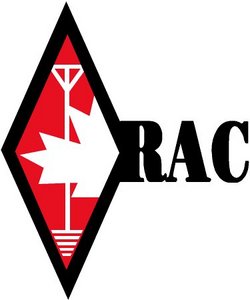 "This proposal will be [submitted] at the
"This proposal will be [submitted] at the 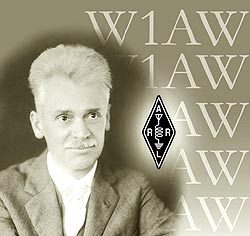 The
The 
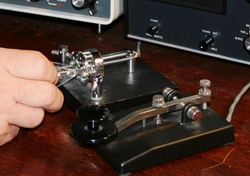 The computer-generated Morse data for the competition includes various levels of added noise. The signal-to-noise ratio, speed, and message content of the files vary randomly to simulate real-life ham radio HF Morse communication.
The computer-generated Morse data for the competition includes various levels of added noise. The signal-to-noise ratio, speed, and message content of the files vary randomly to simulate real-life ham radio HF Morse communication.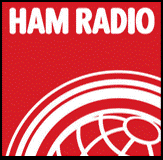 PowerPoint presentations in English include "The Enigma and Other famous Cipher Machines" by Tom Perera, W1TP; "FT5ZM -- Amsterdam Island DXpedition" by Ralph Fedor, K0IR; "K9W -- Wake Atoll 2013 Commemorative Expedition" by Lou Dietrich, N2TU, and "VK9MT -- Mellish Reef DXpedition" by Leslie P. Kalmus, W2LK. The German-language presentation "Yagi und Quad Antennen für den Kurzwellenamateur" ("Yagi and Quad Antennas for HF") by Martin Steyer, DK7ZB, also is available.
PowerPoint presentations in English include "The Enigma and Other famous Cipher Machines" by Tom Perera, W1TP; "FT5ZM -- Amsterdam Island DXpedition" by Ralph Fedor, K0IR; "K9W -- Wake Atoll 2013 Commemorative Expedition" by Lou Dietrich, N2TU, and "VK9MT -- Mellish Reef DXpedition" by Leslie P. Kalmus, W2LK. The German-language presentation "Yagi und Quad Antennen für den Kurzwellenamateur" ("Yagi and Quad Antennas for HF") by Martin Steyer, DK7ZB, also is available.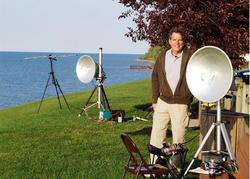
 the Boy Scouts of America's Radio Scouting Committee, president of the K2BSA Amateur Radio Association, and member of the World Scouting JOTA-JOTI Team.
the Boy Scouts of America's Radio Scouting Committee, president of the K2BSA Amateur Radio Association, and member of the World Scouting JOTA-JOTI Team.
 "Stu was a very active national volunteer, who called the Cincinnati Chapter of the American Red Cross his home base," said ARRL Public Information Officer Cindy Ebner, K8CJE, an ARC volunteer. "He volunteered numerous hours helping maintain their Amateur Radio station (W8VVL), [and] worked closely with the IT team to grow and maintain the network." The DST team oversees the technical component of a response. It also can serve as a liaison between local Amateur Radio groups and the ARC to facilitate initial emergency communication.
"Stu was a very active national volunteer, who called the Cincinnati Chapter of the American Red Cross his home base," said ARRL Public Information Officer Cindy Ebner, K8CJE, an ARC volunteer. "He volunteered numerous hours helping maintain their Amateur Radio station (W8VVL), [and] worked closely with the IT team to grow and maintain the network." The DST team oversees the technical component of a response. It also can serve as a liaison between local Amateur Radio groups and the ARC to facilitate initial emergency communication.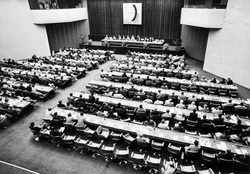
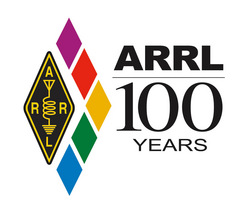 In 1980 the ARRL Board of Directors established a Long-Range Planning Committee, to look far into the future and plan for Amateur Radio to remain strong enough to weather the efforts of other radio services to chip away at our frequency allocations. The LRPC was also tasked to find ways to strengthen the cooperation between Amateur Radio and governmental agencies at all levels.
In 1980 the ARRL Board of Directors established a Long-Range Planning Committee, to look far into the future and plan for Amateur Radio to remain strong enough to weather the efforts of other radio services to chip away at our frequency allocations. The LRPC was also tasked to find ways to strengthen the cooperation between Amateur Radio and governmental agencies at all levels.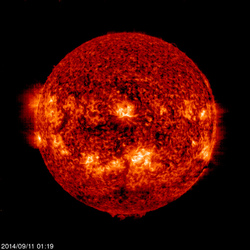 Spacenews.com
Spacenews.com







